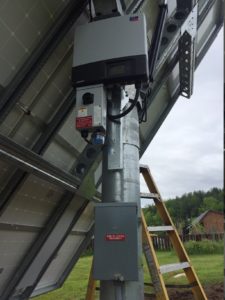Solar tracking system in a field of flowers. Photos by Stephanie Williams, Solar Store of Greenfield.
By George Harvey
Many people who are interested in installing solar systems at their homes think in terms of an array mounted on the roof, or one mounted on the ground in a fixed position, pointing at the average position of the noonday sun. If they want to get the maximum value out of their solar panels, however, they might want to consider going beyond these two scenarios and think of a third alternative, solar trackers.
Tracking mounts are more expensive than fixed mounts, so they add to the overall cost of installation. On the other hand, they can be the more economical choice. They make far more efficient use of the investment into solar panels, because they produce considerably more electricity from the same amount of sunshine. They produce about 35% to 40% more electricity from the same number of solar panels.
Claire Chang and John Ward, who operate the Solar Store of Greenfield (SSG) in Greenfield, Massachusetts, have been installing tracking systems made by AllEarth Renewables in Williston, Vermont since 2014. Chang explained the advantage of tracking. “The production curve from a fixed array is a bell curve,” Chang said. That is because a fixed system is only pointing directly at the sun at noon. By contrast, the tracking system points its panels directly at the sun as soon as the sun appears, and it keeps them pointing directly at the sun until the sun sets, so the change to and from maximum output is steep. Chang said, “The tracker’s curve is a very broad peak through a sunny day. It is shaped like a sandwich bread loaf.”
There is more to the tracker’s motions than that, however. The mount has an anemometer to keep track of wind speed. When the winds get too strong, (upwards of 30 miles per hour), the array moves into a horizontal position. This not only prevents the wind from damaging the solar panels by not pulling and pushing on them, it also makes them much less vulnerable to being hit by wind-blown objects. The system is rated to withstand winds of up to 120 miles per hour.
Another issue for solar systems is snow loads. The AllEarth Renewable trackers automatically shed snow by pointing north and setting the panels at a steep angle.
SSG is not a big business, and it shares work with partners. The trackers are mounted on concrete bases, with preparation and installation done by Renaisance Excavating, in Gill, Massachusetts. SSG also partners with Torrico Electric in Sheffield, Massachusetts for electrical work. By doing this, SSG is able to focus specifically on getting to the best solar solutions for a given site.
Customers we have talked with are very pleased with their systems. Joseph Graveline had his system installed in the spring of 2015 and saw it come online in June. Asked about his experience, he said, “It is an amazing system. One thing that makes it is so amazing is that I never have to think about it.” He clearly does enjoy thinking about it from time to time, however. When we talked with him he had just taken a look at its output. “It was 7,100 watts at 4:00 pm.” That is not bad for a late afternoon in the winter, considering that the tracker with 24 panels, each of 300 watts, has a total rated capacity of 7,200 watts.
Stacy Bond, another customer, said, “We don’t pay any electricity bill, which is fabulous.” She also praised Claire Chang for her ability to answer questions clearly.
Chang was careful to point out that trackers cannot be installed just anywhere. A site evaluation is one of the first steps toward having a solar system installed. They may require special permitting in some communities and are subject to rules covering a range from zoning to wetland conservation. It is also necessary for the location to be shade-free from about 7:00 AM to 7:00 PM to take full advantage of the tracking systems. Even so, many locations are suitable for them, and Chang said about half of SSG’s installations use them.
The website for Solar Store of Greenfield is http://solarstoreofgreenfield.com/.









Leave a Reply